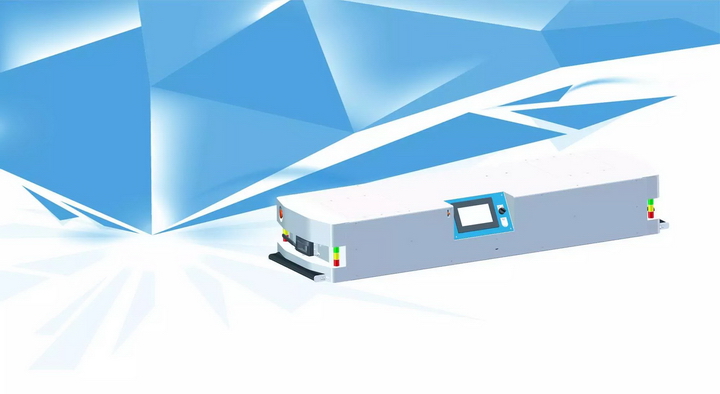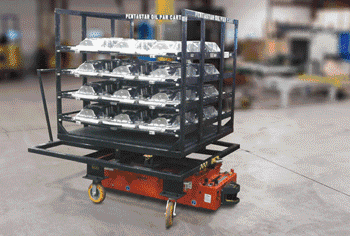
AGV是自动导引运输车(Automated Guided Vehicle)的英文缩写,指装备有电磁或光学等自动导引装置,能够沿规定的导引路径行驶,具有安全保护以及各种移载功能的运输车,AGV属于轮式移动机器人(WMR――Wheeled Mobile Robot)的范畴。
AGC(Automated Guided Cart),属于AGV的一类,但由于具有独特的功能与用途,将它单独出来讲。AGC是以日本为代表的简易型AGV技术,该技术追求的是简单实用,极力让用户在最短的时间内收回投资成本。该类AGV完全结合简单的生产应用场合(单一的路径,固定的流程),AGC只是用来进行搬运,并不强调AGV的自动装卸功能。由于日本的基础工业发达,AGC生产企业能够为AGC配置上几乎简单得不能再简单的功能器件,使AGC的成本几乎降到了极限。
1. Definition of AGV and AGC
AGV is the English abbreviation of Automated Guided Vehicle, which refers to a transport vehicle equipped with automatic guidance devices such as electromagnetic or optical, which can travel along a prescribed guiding path, and has safety protection and various transfer functions. AGV belongs to the category of Wheeled Mobile Robot (WMR-Wheeled Mobile Robot).
AGC (Automated Guided Cart), belongs to a category of AGV, but because of its unique functions and uses, it will be discussed separately. AGC is a simple AGV technology represented by Japan. The technology pursues simplicity and practicality, and strives to allow users to recover their investment costs in the shortest possible time. This type of AGV is completely combined with simple production applications (single path, fixed process), AGC is only used for handling, and does not emphasize the automatic loading and unloading function of AGV. Due to the developed basic industry in Japan, AGC manufacturers can configure AGC with functional devices that are almost as simple as they can be, making the cost of AGC almost reduced to the limit.

1、驱动方式不同
在工业现场应用的AGV,考虑到稳定可靠等因素重要性,AGV一般采用伺服电机驱动,电机与轮系为一体式结构,价格较贵。而AGC只满足简单物流输送要求,一般采用普通直流电机驱动,价格较低。
2、定位精度不同
AGV定位精度标准为±10mm,可以满足AGV上的输送机与地面的输送机对接的要求。
AGC定位精度标准为±20mm,无法保证与地面输送机自动精确定位对接。
3、速度控制方式不同
AGV在直线段和弯道段的速度不同,可以保证在弯道时AGV搭载的货物不会因为离心力大而倾覆。
AGC在直线段和弯道段的速度相同。若同为高速,则在弯道时会非常危险。若同为低速,则很难满足工作节拍要求。一般厂家在使用AGC运行路线的弯道段地面上安装了一段角钢,用来强行矫正AGC在转弯时轮子的运行轨迹,否则AGC会偏离运行路线。
4、非接触式障碍探测装置不同
AGV采用漫反射式激光传感器作为接近式障碍探测装置,一般为原装进口,有效探测距离为4m,对人员、设备均有非常良好的探测效果。AGC采用红外传感器作为接近式障碍探测装置,因为红外传感器对不同物体的探测距离由该物体的反射能力决定(例如金属物体的反射能力比人员高),所以无法保证达到所标定的探测距离(2m),为了保证探测到障碍物时有足够的刹车距离,AGC的运行速度一般较低。
5、与地面输送设备的互锁
国家标准《GB/T 20721—2006 自动导引车通用技术条件》第4.3.2 条款规定,“在自动导引车上安装与地面移载装置的连锁功能。在移载过程中任意一方的意外故障,都应通知对方,并及时处理,防止货物或设备的损坏。发生移载故障后,在排除故障之前,系统应维持停止状态”。
AGV与地面输送设备之间采用红外对射开关的方式进行互锁,当AGV到达移载位置并且互锁成功时,AGV的控制台与地面输送设备的控制台之间进行通信,AGV才能与地面输送设备进行移载。移载结束后,AGV控制台与地面设备控制台再次通信,解除互锁,AGV才能够离开此移载位置,去执行下一个任务。
AGC因为定位精度不够,无法与地面输送设备进行自动移载,没有互锁功能。
6、控制台
国家标准《GB/T 20721—2006 自动导引车通用技术条件》第4.3.3 C)条款规定,“在自动导引车与控制台间应该具有调度和控制功能”。
AGV采用中央控制台集中控制的方式,在中央控制台能够实时动画显示每台AGV的当前状态,中央控制台能够对每台AGV分别调度,并且能够调度AGV之间避免发生碰撞。
有的AGC系统虽然有中央控制台,但不能做到对每台AGC进行分别调度,也不能调度AGC之间避碰。
7、与上层系统的连接
AGV作为自动运行设备,实质上是客户的系统的一个子系统,虽然AGV能够作为独立的系统运行,但必须接受客户的指令去完成某项工作,待工作完成后向客户的系统回报本项任务完成,并接受下一个任务。也就是说AGV与客户的系统(对AGV系统而言是上层系统)之间必须连接,进行数据的交换。
AGC不能够与上层系统进行连接(所有AGC实例均可证明这一点),这是AGV与AGC最关键的差别。
2. All-round comparison between AGV and AGC
(1) Different driving methods
Considering the importance of stability and reliability for AGVs used in industrial fields, AGVs are generally driven by servo motors, and the motor and the wheel train are integrated, which is expensive. However, AGC only meets the requirements of simple logistics and transportation, and is generally driven by ordinary DC motors, and the price is low.
(2) Different positioning accuracy
The AGV positioning accuracy standard is ±10mm, which can meet the requirements of docking between the conveyor on the AGV and the conveyor on the ground.
The AGC positioning accuracy standard is ±20mm, which cannot guarantee automatic and precise positioning and docking with the ground conveyor.
(3) Different speed control methods
The speed of the AGV in the straight section and the curved section is different, which can ensure that the goods carried by the AGV will not overturn due to the large centrifugal force during the curve.
The speed of the AGC is the same in straight and curved sections. If both are at high speed, it will be very dangerous when cornering. If the speed is both low, it is difficult to meet the work rhythm requirements. Generally, manufacturers install a section of angle steel on the ground of the curved section of the AGC running route to forcibly correct the running track of the wheels of the AGC when turning, otherwise the AGC will deviate from the running route.
(4) Different non-contact obstacle detection devices
The AGV uses a diffuse reflection laser sensor as a proximity obstacle detection device, which is generally imported, and the effective detection distance is 4m, which has a very good detection effect on personnel and equipment. AGC uses infrared sensor as a proximity obstacle detection device, because the detection distance of infrared sensor to different objects is determined by the reflection ability of the object (for example, the reflection ability of metal objects is higher than that of people), so it cannot guarantee to reach the calibrated detection distance (2m ), in order to ensure sufficient braking distance when an obstacle is detected, the running speed of AGC is generally low.
(5) Interlock with ground conveying equipment
Clause 4.3.2 of the national standard "GB/T 20721-2006 General Technical Conditions for Automatic Guided Vehicles" stipulates that "the interlocking function with the ground transfer device is installed on the automatic guided vehicle. In case of failure, the other party should be notified and dealt with in time to prevent damage to the goods or equipment. After a transfer failure occurs, the system should remain in a stopped state until the failure is eliminated.”
The AGV and the ground conveying equipment are interlocked by means of an infrared beam switch. When the AGV reaches the transfer position and the interlock is successful, the AGV's console and the ground conveying equipment's console communicate with each other, so that the AGV can communicate with the ground. Transfer equipment for transfer. After the transfer is completed, the AGV console communicates with the ground equipment console again to release the interlock, and the AGV can leave the transfer position to perform the next task.
Because the positioning accuracy of the AGC is not enough, it cannot be automatically transferred with the ground conveying equipment, and there is no interlocking function.
(6) Console
Clause 4.3.3 C) of the national standard "GB/T 20721-2006 General Technical Conditions for Automatic Guided Vehicles" stipulates that "there should be scheduling and control functions between the automatic guided vehicle and the console".
The AGV adopts the centralized control method of the central console. The current status of each AGV can be displayed in real-time animation in the central console. The central console can schedule each AGV separately, and can schedule AGVs to avoid collisions.
Although some AGC systems have a central console, they cannot schedule each AGC separately, nor can they schedule collisions between AGCs.
(7) Connection to higher-level systems
As an automatic operation device, AGV is essentially a subsystem of the customer's system. Although AGV can operate as an independent system, it must accept the customer's instructions to complete a certain work, and report the task to the customer's system after the work is completed. Done, and accept the next mission. That is to say, the AGV and the customer's system (the upper-layer system for the AGV system) must be connected to exchange data.
AGC cannot connect with the upper-layer system (all AGC instances can prove this), which is the most critical difference between AGV and AGC.

AGV的控制比较复杂,从行走姿态到多车的调度管理都有特殊的算法。而AGC却简单得多,一个PLC就可能搞定。由于存在着功能和价格上的明显差异,所以用户在实施项目前,应仔细分析需求,以确定AGV或AGC。
结合两者的技术特性,一般在同时满足以下几种情况的时候,可以选择AGC。
1、单一的路径。即AGV运行的环路中没有分支,单一的环路。
2、固定的流程。即AGV每个任务循环都重复同样的动作,即每个循环停车点的位置顺序是不变的。如:AGV在循环中A,B,C点三点都可能需要停车,那么A,B,C就是AGV停车的顺序,AGV不可能直接从A点直接到C点,在B点无论有无工作都要停车。当然固定的流程是指预设的流程,可以有多个。但不管怎样,流程都是人为预知的,是预先设定的,而不是上位计算机根据调度策略的计算所得。
3、对AGV的导引及定位精度要求不高,只需AGV将货物运送到大致的位置即可。
4、不需要移载机构,通常是由人工装载、卸载或采用拖拽式AGC。
除此之外,对于运行的环路中有多个分支、多个环路、有合流、分流的复杂路径,多变的流程,较高的定位要求,需完成较复杂的装卸任务的情况下,就应该选择AGV。
一套优质的AGV系统应当具备以下几个条件:高质量的车身结构及机械、电子、通讯配套设施,易操作、易配置、易扩展且功能强大的控制系统,精密的定位系统,强大的驱动系统,可靠的安全系统,能有美观的外形就更好了。
3. Under what circumstances to choose AGV & AGC
The control of AGV is more complicated, and there are special algorithms from walking posture to multi-vehicle scheduling management. The AGC is much simpler, and a PLC may do it. Due to the obvious differences in function and price, users should carefully analyze the requirements to determine the AGV or AGC before implementing the project.
Combining the technical characteristics of the two, generally when the following conditions are met at the same time, AGC can be selected.
(1) A single path. That is, there are no branches in the loop in which the AGV operates, but a single loop.
(2) Fixed process. That is, the AGV repeats the same action for each task cycle, that is, the position sequence of each cycle parking point is unchanged. For example: AGV may need to stop at three points A, B, and C in the cycle, then A, B, and C are the order of AGV parking. It is impossible for AGV to go directly from point A to point C, regardless of whether there is work at point B All parking. Of course, a fixed process refers to a preset process, and there can be multiple ones. But in any case, the process is predicted by humans and is preset, not calculated by the upper computer according to the scheduling strategy.
(3) The guidance and positioning accuracy of the AGV is not high, and the AGV only needs to transport the goods to the approximate location.
(4) No transfer mechanism is required, usually manual loading, unloading or drag-type AGC.
In addition, when there are multiple branches, multiple loops, complex paths with confluence and diversion in the running loop, changeable processes, high positioning requirements, and more complex loading and unloading tasks need to be completed , you should choose AGV.
A high-quality AGV system should have the following conditions: high-quality body structure and mechanical, electronic, and communication facilities, easy-to-operate, easy-to-configure, easy-to-expand and powerful control systems, precise positioning systems, and powerful drives system, reliable security system, it is better to have a beautiful appearance.